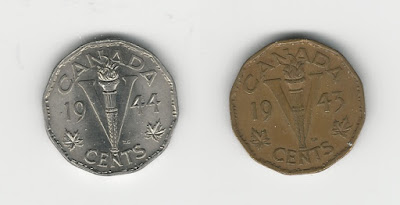Coins were invented about 600 BCE, about 3000 years after money (as we understand it) was invented. Within three generations, by 500 BCE, coins had acquired most of the attributes that associate with them today. Perhaps first among them, both in time and importance, was carrying a message. As signifiers or semata, coins paralleled the ascendance of writing over speech to extend the width and depth of communication.
During World War II, Canada included a patriotic message on its 5-cent coins: We win when we work willingly. The slogan was in Morse code, flush along the rim of the reverse. While not obvious, neither was it intended to be secret. Rather, the message was an element of the propaganda effort. Another wartime effort was Canada’s use of tombac, an 88-12 alloy of copper and zinc to replace nickel on the 5-cent coins of 1942 and 1943.
 |
| WE WIN WHEN WE WORK WILLINGLY |
In the United States, the 5-cent nickel became one-third (35%) silver from 1942 to 1945. The story was that we needed the nickel for armor plate. In truth, we got our nickel from Sudbury, Ontario, and it was plentiful. The new nickels had a large Mintmark over Monticello on the reverse. The fractional coinage (“small change”) of the United State and Canada delivered constant reminders to the general population.
 |
Canada 5-cent nickel (left) and 5-cent tombac (right)
war time issues with Morse code message at rim. |
In our time, the US “Native American” (Sacagawea) dollars for 2016 honor the Code Talkers. At first, during World War I, Native American soldiers worked as telephone operators because it was unlikely that Germans (who did know English) would know their languages. In addition, the Americans quickly adopted slang of their own to add a layer of obfuscation.
World War II was a much larger and longer engagement. In 1943, the total population of the USA was 136.7 million, of whom 9.2 million were in the armed forces. Although American civilians who were ethnically Japanese were placed in concentration camps, their sons were allowed to join the armed forces (and fight in Europe). So, of course, the military tapped a new generation of Native American Code Talkers.
Although the Navajo are best known from books and a recent movie, in fact, they came from over 30 communities and societies: Cherokee Nation, Cheyenne and Arapaho Tribes, Cheyenne River Sioux Tribe, Choctaw Nation, Comanche Nation, Crow Creek Sioux Tribe, Crow Nation, Fond du Lac Band of Lake Superior Chippewa Tribe, Fort Peck Assiniboine and Sioux Tribes, Ho-Chunk Nation, Hopi Tribe, Kiowa Tribe, Lower Brule Sioux Tribe, Menominee Nation, Meskwaki Nation, Muscogee (Creek) Nation, Oglala Sioux Tribe, Oneida Nation, Osage Nation, Pawnee Nation, Ponca Tribe, Pueblo of Acoma Tribe, Pueblo of Laguna Tribe, Rosebud Sioux Tribe, Santee Sioux Nation, Seminole Nation, Sisseton Wahpeton Oyate (Sioux) Tribe, St. Regis Mohawk Tribe, Standing Rock Sioux Tribe, Tlingit Tribe, Tonto Apache Tribe, White Mountain Apache Tribe, Yankton Sioux Tribe. (See the US Mint sales pages for special medals and medallions here.)
 |
Reverse of US Mint 2016 Native American Dollar
honors the Code Talkers from two wars. |
On the other side of the Atlantic the British were engaged in a “wizard war” against the Germans. Among their “boffins” were the codebreakers of Bletchley Park. The Imitation Game told the story of Alan Turing and his failed romance with Elisabeth Lowther Clarke (later Murray). Clarke was a brilliant mathematician, and an accomplished codebreaker. After the war, she took up a numismatics, largely as a result of her husband John Kenneth Murray’s collection of Scottish coins. In particular, several series of silver groats and gold “unicorns” were not well identified or sequenced as the weights and finenesses had changed during the reigns of James III and James IV. She figured it all out, publishing and delivering papers. (See “The Early Unicorns and the Heavy Groats of James III and James IV” in the British Numismatic Journal, Volume 40, Number 8, 1971 online here.)
For that work, the British Numismatic Society granted her a John Sanford Saltus Gold Medal in 1986. You can find a brief biography in Wikipedia, of course, but as Joan Clarke. Lord Stewartby (Bernard Harold Ian Halley Stewart), one of her collaborators in the coinage of Scotland, wrote her obituary for the British Numismatic Journal Vol. 67 No. 13, pages 162-167, online here.)
(See, also, my review of The Imitation Game with pictures of two computer security challenge coins in the E-Sylum newsletter of the Numismatic Bibliomania Society here.)
PREVIOUSLY ON NECESSARY FACTS



No comments:
Post a Comment
Note: Only a member of this blog may post a comment.